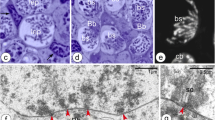Summary
The formation of the extranuclear annulate lamellae has been revealed to be connected with a process of nuclear emission which is very active during the previtellogenetic stages of the Boltenia oocyte development. This process involves both of the nuclear membranes. At many spots on the surface of the nuclear envelope, the outer membrane pulls away from the inner membrane, thus forming what has been designated as “blisters” of various sizes and shapes. Masses of nuclear content, apparently not from the nucleolus, are pushed into the blisters. These blisters may become detached from the nuclear envelope and lie free in the cytoplasm. But in many cases, the detachment seems delayed, and in each blister many emission masses are squeezed tightly together and flat one on top of the other. These masses, in sections, may present the appearance of a stack of elongated outlines. The membrane, limiting any two adjacent masses in close contact, develop annuli. It is thus that an annulate lamella is formed. Whether an annulate lamella is formed between a pair of neighboring masses depends on their proximity. So the production of the annulate lamellae is incidental to, but not a necessary part of the process of nuclear emission. After the original outer nuclear membrane forming the blister has disintegrated, the annulate lamellae are left exposed in the cytoplasm.
It is clear that, 1. both membranes of an annulate lamella are of inner nuclear membrane origin, 2. they hold between them some of the content of the enlarged perinuclear space resulting from the raising of the outer nuclear membrane when the blister is formed, and 3. the material held between any two lamellae is from the nucleus.
The intranuclear annulate lamellae simply arise from the narrow pouches formed by the inner nuclear membrane towards the interior of the nucleus, and on these narrow pouches annuli are developed. So the intranuclear annulate lamellae is also composed of two membranes of an inner nuclear membrane origin holding between them a quantity of the content of the perinuclear space.
Similar content being viewed by others
References
Afzelius, B. A.: The ultrastructure of the nuclear membrane of the sea urchin oocyte as studied with the electron microscope. Exp. Cell Res. 8, 147–158 (1955).
Gay, H.: Structural evidence for nucleo-cytoplasmic interrelations in Drosophila. Anat. Rec. 122, 469–480 (1955).
—: Chromosome-nuclear membrane-cytoplasmic interrelations in Drosophila. J. biophys. biochem. Cytol. 2, Suppl. 407–414 (1956).
Hadek, R., and H. Swift: Nuclear extrusion and intracisternal inclusions in the rabbit blastocyst. J. Cell Biol. 13, 445–451 (1962).
Hsu, W. Siang: The nuclear envelope in the developing oocytes of the tunicate, Boltenia villosa. Z. Zellforsch. 58, 660–678 (1963).
Kaufmann, B. P., and H. Gay: The nuclear membrane as an intermediary in gene-controlled reactions. Nucleus 1, 47–74 (1958).
Kessel, R. G.: Electron microscope studies on the origin of annulate lamellae in oocytes of Necturus. J. Cell Biol. 19, 391–414 (1963).
—: Intranuclear and cytoplasmic annulate lamellae in Tunicate oocytes. J. Cell Biol. 24, 471–487 (1965).
—: Ultrastructure and relationships of ooplasmic components in Tunicates. Acta Embryol. Morph. exp. (Palermo) 9, 1–24 (1966a).
—: An electron microscope study of nuclear-cytoplasmic exchange in oocytes of Ciona intestinalis. J. Ultrastruct. Res. 15, 181–196 (1966b).
—: Some observations on the ultrastructure of the oocyte of Thyone briareus with special reference to the relationship of the Golgi complex and endoplasmic reticulum in the formation of yolk. J. Ultrastruct. Res. 16, 305–319 (1966c).
King, R. C., and R. L. Devine: Oogenesis in adult Drosophila melanogaster. Growth 22, 299–326 (1959).
Mancuso, V.: Ultrastructural changes in the cytoplasm of Ciona intestinalis. Acta Embryol. Morph. exp. (Palermo) 7, 269–295 (1964).
Merriam, R. W.: The origin and fate of annulate lamellae in maturing sand dollar eggs. J. biophys. biochem. Cytol. 12, 79–90 (1959).
Norrevang, Arne: Oogenesis in Priapulus caudatus Lamarck. Vidensk. Medd. Dansk naturh. Foren. 128, 1–83 (1965).
Okada, E., and C. H. Waddington: The submicroscopic structure of the Drosophila egg. J. Embryol. exp. Morph. 7, 583–597 (1959).
Swift, H.: The fine structure of annulate lamellae. J. biophys. biochem. Cytol., Suppl. 2, 415–418 (1956).
Wischnitzer, S.: The amphibian oocyte nucleus. Nucleus 4, 177–198 (1961).
Author information
Authors and Affiliations
Additional information
Supported by Grant GM-11858 of National Institute of Health. The author is indebted to Dr. Richard Cloney of the Department of Zoology, University of Washington, for the use of the electron microscope.
Rights and permissions
About this article
Cite this article
Hsu, W.S. The origin of annulate lamellae in the oocyte of the ascidian, Boltenia villosa stimpson. Zeitschrift für Zellforschung 82, 376–390 (1967). https://doi.org/10.1007/BF00323861
Received:
Issue Date:
DOI: https://doi.org/10.1007/BF00323861




